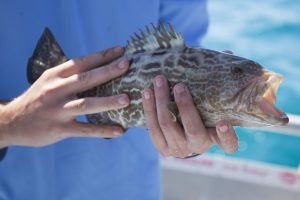A few weeks ago, my physical therapist, an avid fisherman, got into a debate with another therapist in the practice. I was called in as the judge to answer the question at hand: can fish feel pain? My therapist said that he didn’t think so, while the other therapist believed that fish do feel pain. My answer: “I’m not sure.” I then put a call into my esteemed colleague Dr. Angela Collins, who directed me to a bunch of scientific papers and an answer that still wasn’t cut and dry: “this is a highly debated topic among fish experts.” I decided to dive into reading to see what I could find out.
The review of the papers that Angela provided me, along with others that I found was simultaneously interesting and confusing. It appears that there is quite a bit of controversy on this topic, with both stances proving to be well-argued. There is a great deal of science and anatomy that goes into categorizing and determining pain! Pain determination is challenging, as humans are accustomed to determining physical or emotional trauma through verbal cues. Obviously, this does not work well to measure presence or absence of fish pain.
Let’s start with an important vocabulary term: nociceptor. A nociceptor is a sensory receptor for painful stimuli, causing an immediate reflex withdrawal from the source. In humans, these are found all over the body and in the organs. In certain species of fish, they are commonly found on the face and head. Nociceptors are often the center of this debate, as their location or function in fish is not quite the same as found in other vertebrates.

The “yay” corner
Scientist Lynne Sneddon and Victoria Braithwaite, among others indicate that fish do in fact experience pain:
- Fish are capable of nociception, this phenomenon was confirmed in teleost (bony) fishes in 2002
- Fish change behavior when influenced by environmental factors or administered certain painful stimuli
- After a potentially painful event, behavior alteration and avoidance have been observed, particularly if the event involved a tissue injury
- Analgesic drugs administered during experiments indicate that responses to painful stimuli are due to nociceptors and pain receptors
The “nay” corner
Scientists including Benjamin Diggles, Brian Key, JD Rose and others conclude that fish do not experience pain for a number of reasons:
- Fish lack neural tissue required for pain sensing, therefore cannot feel it.
- Humans project feelings of pain to animals if reaction to stimuli.
- Typical research experiments performed to mimic pain are not repeatable in real life
- Responses to stimuli aren’t necessarily indicative of pain
- Fleeing noxious stimuli can be a response to reflexes developed in spine
- Brain activity does not equal pain
As you can see, this is a highly complex topic and still being heavily studied. Whichever way you lean in this argument, from an ethical and moral perspective, a best practice is to go with the thought that fish (and other animals) can and do feel pain and do what you can to minimize their discomfort. This is of particular importance here in Florida, where recreational and commercial fishing exists 365 days a year.
Fortunately, UF/IFAS Extension and Florida Sea Grant have developed two fantastic online courses to assist anglers in learning best practices for fishing. The Florida Friendly Fishing Guide is aimed a charter captains and private guides. The cost is $130 and certifies the operator for three years and is then listed on the Florida Sea Grant website. The free Florida Friendly Angler course is geared towards the recreational angler and teaches about local ecology and best practices.
Depending on the fish species, bag limit and season, you may find that you need to release your catch. To do this successfully, consider the following best practices:
For catching:
- Target open species
- Fish in shallower waters
- Limit fight time
- Use corrosive, non-stainless steel circle hooks
For releasing:
- Work with bare, wet hands
- Use a de-hooking device
- For deeper water (>30’), descend or properly vent fish
- Minimize handling time
While I can’t settle the debate between my physical therapists, I can offer these fishing best practices. By employing these skills, anglers can help minimize fish pain and help to ensure that the fish caught can live to grow larger, reproduce, and keep our fisheries sustainable for years to come.
References:
Diggles, B., Arlinghaus, R., Browman, H., Cooke, S., Cooper, R., Cowx, I., Derby, C., Derbyshire, S., Hart, P., Jones, B., Kasuyan, A., Key, B., Pepperell, J., Rogers, C., Rose, J., Schwab, A., Skiftesvik, A., Stevens, D., Shields, J., Watson, C. 2023. Reasons to be skeptical about sentience and pain in fishes and aquatic invertebrates. Reviews in Fisheries Science & Aquaculture. 25pp.
Hart, P. 2010. Book Review: Do fish feel pain? By Victoria Braithwaite. Animal Behavior, Vol 80, p. 591-592.
Key, B. 2015. Fish do not feel pain and its implications for understanding phenomenal consciousness. Biology & Philosophy, Vol 30 (2), p. 149-165.
Rose, J., Arlinghaus, R., Cooke, S., Diggles, B., Sawynok, W., Stevens, E., Wynne, C. 2014. Can fish really feel pain? Fish and Fisheries, Vol 15, p. 97-133.
Sneddon, L. 2019. Evolution of nociception and pain: evidence from fish models. Philosophical Transactions B. Vol 374, 8pp.
Sneddon, L. 2015. Pain in aquatic animals. The Journal of Experimental Biology, Vol 218, p. 967-976.
Sneddon, L. 2009. Pain perception in fish: indicators and endpoints. ILAR Journal, Vol 50 (4), p. 338-342.
Sneddon, L., Braithwaite, V., Gentle, M. 2003. Do fishes have nociceptors? Evidence for the evolution of a vertebrate sensory system. The Royal Society, Vol 270, p. 1115-1121.
 3
3
